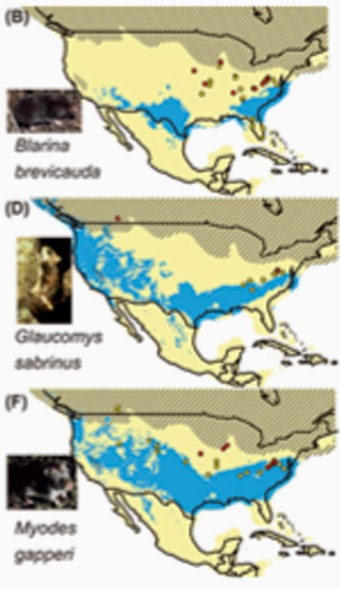
Leave it to long-dead short-tailed shrew and flying squirrels to outfox climate-modelers trying to predict future habitats.
Evidence from the fossil record shows that gluttonous insect-eating shrew didn’t live where a species distribution technique drawn by biologists put it 20,000 years ago to survive the reach of glaciers, says University of Oregon geologist Edward B. Davis. The shrew is not alone.
According to a new study by Davis and colleagues, fossil records of five ancient mammalian species that survived North America’s last glacial period point to weaknesses in the use of ecological niche models and hindcasting to predict future animal and plant habitats. As a result, Davis says, the modeling needs to be fine-tuned for complexities that might be harvested from fossils.
Ecological niches use modern habitat distributions and climate; hindcasting adds predictive power by adding major past climate shifts into the models. That modeling combination — as seen in a 2007 study led by Eric Waltari, then of the American Museum of Natural History in New York — had the short-tailed shrew surviving the last ice age in mostly Texas and the Deep South. Conclusions drawn in other studies, Davis noted in the new study, also are biased toward southern locations for ice-age surviving mammals of the Pleistocene Epoch.

Short-tailed shrew, according to fossil records, did not live in the predicted ranges. Instead they lived across north central and northeast United States, closer to the glaciers and where they are widely found today.
“It’s almost as though it is living in all of the places that the model says it shouldn’t be living in and not in any of the places that the model says it should be living in,” said Davis, who also is manager of the paleontological collection at the UO Museum of Natural and Cultural History. “This suggests to me that whatever the model is keying on is not actually important to the shrew.”
Nor to the American marten, two species of flying squirrels and the Gapper’s red-backed vole, all of which lived mostly outside of predicted ranges, according to the fossil record. Northern and southern flying squirrels, the Davis study found, shared a compressed geographic region. It may be, Davis said, that some species tolerate competition under harsh conditions but separate when abundant resources are available.
Davis noted that an important but under-cited 2010 paper on rodents by Robert Guralnick of the University of Colorado and Peter B. Pearman of the Swiss Federal Research Institute also showed problems with hindcast projections. Those for lowland rodents in the last ice age did not hold up, but those for a higher elevation species did.
“Our findings say that we need to pay more attention to the potential problems we have with some of our modern methods, and the way that we can improve our understanding of how species interact with the environment,” said Davis, who added that his study was inspired by Waltari’s. “The way to improve our forecasting is to include data from the fossil record. It can give us more information about the environments that species have lived in and could live in.”
The findings appear in the November issue of the journal Ecography. In a special section of the journal, the Davis paper is packaged with four papers on research initially presented in a symposium on conservation paleobiogeography in 2013 at a biennial meeting of the International Biography Society. The Davis paper is co-authored by Jenny L. McGuire, now at Georgia Tech University, and former UO doctoral student John D. Orcutt, who is now at Cornell College in Iowa.
Davis and McGuire co-hosted the symposium, edited the special issue and penned an editorial that accompanies the five papers. Conservation paleobiogeography, Davis said, “is the idea that we can help people understand questions that arise from conservation needs using data from the fossil record.” Doing so, he said, may explain how species shift their ecological roles, or evolve, to survive amid abrupt changes in their habitats.
“Our paper raises questions about some of the work on projecting future ranges of mammals, and we suggest some directions forward,” Davis said. “We have concerns about the precision of the modeling techniques now being used. We don’t have any concerns about climate change happening and that it going to cause geographic range shifts for mammals and plants. The thing I want to do, as a scientist, is to have the best models possible so as we’re making informed decisions as a society.”
Reference:
Edward Byrd Davis, Jenny L. McGuire, John D. Orcutt. Ecological niche models of mammalian glacial refugia show consistent bias. Ecography, 2014; DOI: 10.1111/ecog.01294
Note : The above story is based on materials provided by University of Oregon.










